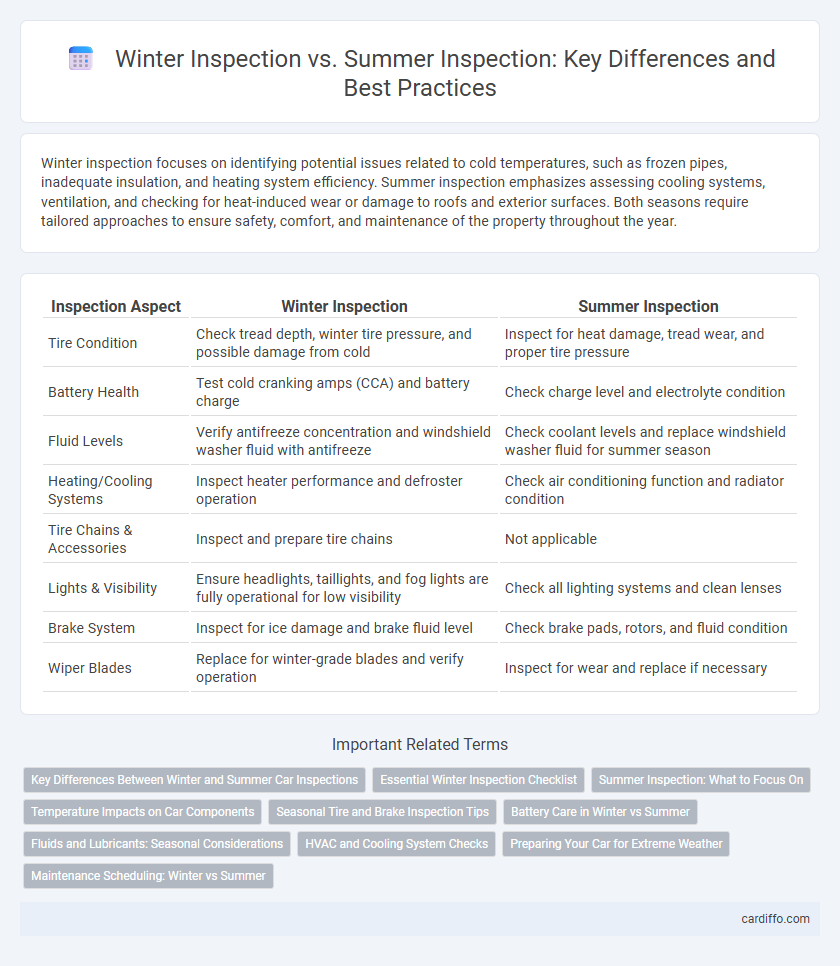Winter inspection focuses on identifying potential issues related to cold temperatures, such as frozen pipes, inadequate insulation, and heating system efficiency. Summer inspection emphasizes assessing cooling systems, ventilation, and checking for heat-induced wear or damage to roofs and exterior surfaces. Both seasons require tailored approaches to ensure safety, comfort, and maintenance of the property throughout the year.
Table of Comparison
| Inspection Aspect | Winter Inspection | Summer Inspection |
|---|---|---|
| Tire Condition | Check tread depth, winter tire pressure, and possible damage from cold | Inspect for heat damage, tread wear, and proper tire pressure |
| Battery Health | Test cold cranking amps (CCA) and battery charge | Check charge level and electrolyte condition |
| Fluid Levels | Verify antifreeze concentration and windshield washer fluid with antifreeze | Check coolant levels and replace windshield washer fluid for summer season |
| Heating/Cooling Systems | Inspect heater performance and defroster operation | Check air conditioning function and radiator condition |
| Tire Chains & Accessories | Inspect and prepare tire chains | Not applicable |
| Lights & Visibility | Ensure headlights, taillights, and fog lights are fully operational for low visibility | Check all lighting systems and clean lenses |
| Brake System | Inspect for ice damage and brake fluid level | Check brake pads, rotors, and fluid condition |
| Wiper Blades | Replace for winter-grade blades and verify operation | Inspect for wear and replace if necessary |
Key Differences Between Winter and Summer Car Inspections
Winter car inspections prioritize checking the battery, antifreeze levels, and tire tread depth to ensure vehicle reliability in cold temperatures and icy conditions. Summer inspections focus more on air conditioning systems, coolant levels, and brake performance to prevent overheating and maintain optimal safety during hot weather. Both inspections assess essential components but target season-specific challenges to enhance overall vehicle safety and performance.
Essential Winter Inspection Checklist
Essential winter inspections prioritize checking heating systems, inspecting insulation integrity, and ensuring roof and gutter conditions to prevent ice dams and heat loss. Winter inspection also includes verifying the functionality of weather stripping and window seals to maintain energy efficiency during colder months. Focusing on these elements minimizes winter-related damages and optimizes home comfort and safety.
Summer Inspection: What to Focus On
During summer inspections, prioritize checking the air conditioning system to ensure optimal cooling performance and prevent overheating. Inspect tires for uneven wear and proper inflation, as high temperatures can affect tire pressure and safety. Evaluate the condition of the cooling system, including radiator and coolant levels, to avoid engine overheating in hot weather.
Temperature Impacts on Car Components
Winter inspections emphasize checking battery performance and cold-weather fluid viscosity to prevent freezing and ensure reliable starts. Summer inspections focus on cooling system efficiency and tire pressure, as high temperatures can cause overheating and pressure fluctuations. Temperature extremes in both seasons critically affect brake functionality, engine health, and tire integrity, necessitating tailored inspection protocols.
Seasonal Tire and Brake Inspection Tips
Seasonal tire and brake inspections are crucial for optimal vehicle safety and performance, with winter inspections emphasizing tread depth and brake responsiveness due to icy conditions. In contrast, summer inspections focus on tire pressure and brake system cooling to prevent overheating and premature wear during hot weather. Regularly checking tire tread, brake pads, and fluid levels ensures reliable handling and stopping power tailored to seasonal demands.
Battery Care in Winter vs Summer
Battery care during winter inspection emphasizes checking the battery's cold cranking amps (CCA) and ensuring proper electrolyte levels to prevent power loss in low temperatures. Summer inspection focuses on inspecting battery terminals for corrosion and ensuring the battery fluid is at optimal levels to handle heat-induced evaporation. Proper seasonal battery maintenance extends battery life and prevents unexpected vehicle starting issues.
Fluids and Lubricants: Seasonal Considerations
Winter inspections require special attention to antifreeze levels and winter-grade engine oil to ensure proper flow and protection against freezing temperatures. Summer inspections prioritize checking coolant concentration and using high-temperature resistant lubricants to prevent overheating and maintain engine performance. Fluids and lubricants must be adapted seasonally to optimize vehicle reliability and prevent mechanical failures.
HVAC and Cooling System Checks
Winter inspections prioritize heating system efficiency, ensuring furnaces, heat pumps, and thermostats function correctly to maintain indoor warmth during cold months. Summer inspections emphasize cooling system performance, including HVAC units, air conditioners, refrigerant levels, and airflow to prevent overheating and ensure optimal climate control. Regular seasonal HVAC and cooling system checks optimize energy usage, reduce repair risks, and extend equipment lifespan.
Preparing Your Car for Extreme Weather
Winter inspection involves checking the battery, antifreeze levels, tire tread, and heater functionality to ensure safe driving in freezing conditions. Summer inspection emphasizes coolant system performance, air conditioning efficiency, and tire pressure to prevent overheating and maintain comfort. Preparing your car for extreme weather includes timely replacement of wiper blades, inspecting brakes, and verifying fluid levels tailored to seasonal demands.
Maintenance Scheduling: Winter vs Summer
Maintenance scheduling during winter inspections prioritizes checking heating systems, insulation, and frost prevention measures to ensure operational efficiency and safety in cold temperatures. Summer inspections emphasize evaluating cooling systems, ventilation, and potential heat-related wear to prevent overheating and maintain structural integrity. Optimizing maintenance tasks seasonally reduces equipment downtime and extends asset lifespan.
Winter inspection vs summer inspection Infographic

 cardiffo.com
cardiffo.com